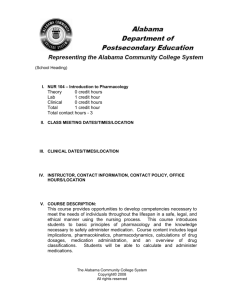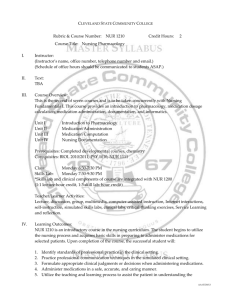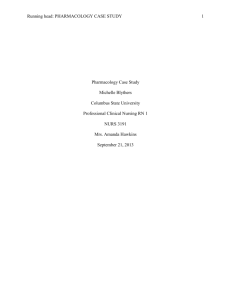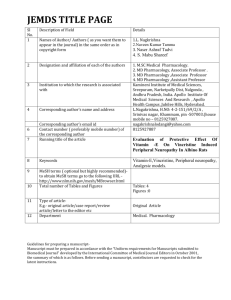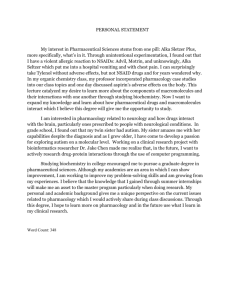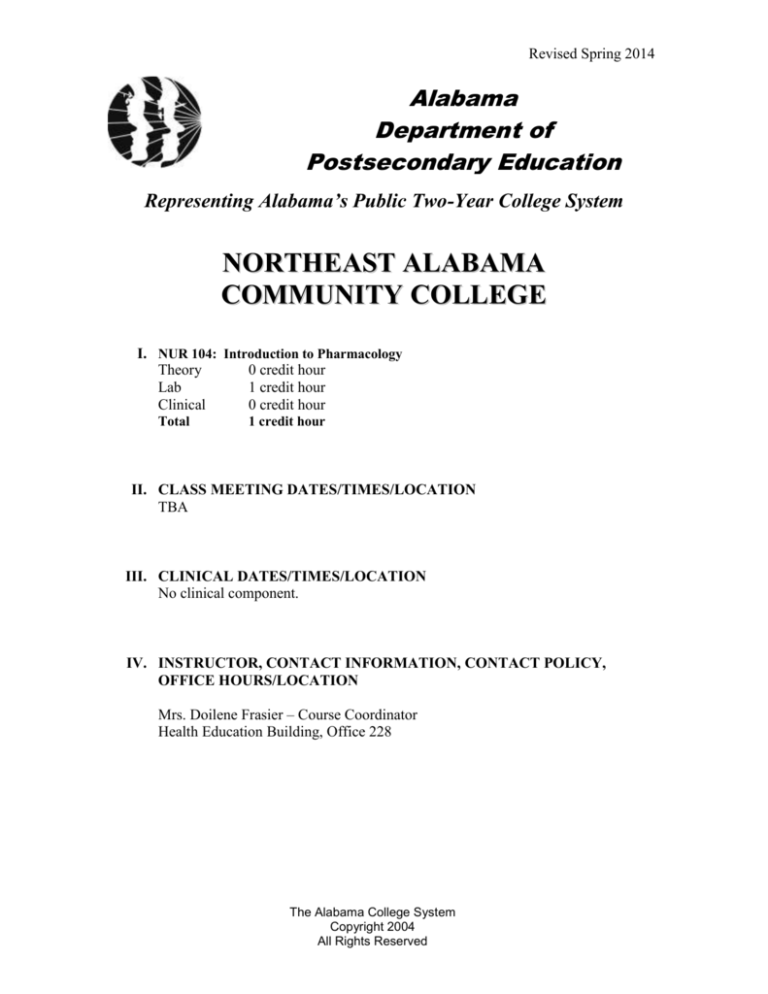
Revised Spring 2014
Alabama
Department of
Postsecondary Education
Representing Alabama’s Public Two-Year College System
NORTHEAST ALABAMA
COMMUNITY COLLEGE
I. NUR 104: Introduction to Pharmacology
Theory
0 credit hour
Lab
1 credit hour
Clinical
0 credit hour
Total
1 credit hour
II. CLASS MEETING DATES/TIMES/LOCATION
TBA
III. CLINICAL DATES/TIMES/LOCATION
No clinical component.
IV. INSTRUCTOR, CONTACT INFORMATION, CONTACT POLICY,
OFFICE HOURS/LOCATION
Mrs. Doilene Frasier – Course Coordinator
Health Education Building, Office 228
The Alabama College System
Copyright 2004
All Rights Reserved
Introduction to Pharmacology
NUR 104
V. COURSE DESCRIPTION:
This course provides opportunities to develop competencies necessary to meet
the needs of individuals throughout the lifespan in a safe, legal, and ethical
manner using the nursing process. This course introduces students to basic
principles of pharmacology and the knowledge necessary to safely administer
medication. Course content includes legal implications, pharmacokinetics,
pharmacodynamics, calculation of drug dosages, medication administration, and
an overview of drug classifications. Students will be able to calculate and
administer medications. This course supports CIP Codes: 51.1601 and 51.1613.
VI. PREREQUISITE(S)/CO-REQUISITE(S)
CO-REQUISITE COURSES:
NUR 102 – Fundamentals of Nursing
NUR 103 – Health Assessment
BIO 201 – Anatomy and Physiology I
MTH 116 – Mathematical Applications (PN Program)
MTH 100 – Intermediate College Algebra (RN Program)
INSTRUCTIONAL NOTE:
Students perform skills in a lab setting for this course.
VII. TEXTBOOK(S) AND OTHER LEARNING RESOURCES
See Reading Assignment
VIII.
COURSE OBJECTIVES
1. Explain foundational concepts associated with pharmacology.
2. Utilize mathematical principles when calculating and preparing dosages.
3. Utilize the nursing process when administering medications to client
throughout the lifespan.
4. Apply knowledge of pharmacokinetics and pharmacodynamics when
administering medications to clients throughout the lifespan.
IX. PROFESSIONAL COMPETENCIES
Explain foundational concepts associated with pharmacology.
Apply mathematical principles in written calculation and problem solving while
preparing dosages.
Administer medications.
Apply knowledge of pharmacokinetics and pharmacodynamics.
The Alabama College System
Copyright 2004
All Rights Reserved
2
Introduction to Pharmacology
NUR 104
MODULE A – INTRODUCTION TO PHARMACOLOGY
A1.0 Explain foundational concepts associated with pharmacology.
A1.1
This module is measured cognitively.
A1.1.1
A1.1.2
A1.1.3
A1.1.4
A1.1.5
A1.1.6
A1.1.7
Define terms associated with pharmacology.
Describe the history of pharmacology.
Identify sources of drugs and drug information.
Define legal and ethical issues in pharmacology.
Explain the Controlled Substance Act.
Explain pharmacodynamics across the lifespan.
Explain pharmacokinetics across the lifespan.
MODULE B – BASIC MATH FOR PHARMACOLOGY
B1.0 Use mathematic operations and formulas to calculate dosages.
B1.1
This module is measured cognitively.
B1.1.1
B1.1.2
B1.1.3
B1.1.4
B1.1.5
B1.1.6
B1.1.7
B1.1.8
B1.1.9
Solve problems using addition operations.
Solve problems using subtraction operations.
Solve problems using multiplication operations.
Solve problems using division operations.
Solve problems using fractions.
Solve problems using decimals.
Solve problems using ratios and proportions.
Perform calculations using various formulas.
Convert between English units of weights and measures
and Standard International units.
MODULE C – ADMINISTERING MEDICATIONS
C1.0 Administer medications.
C1.1
Utilizing the nursing process, administer medications in a
simulated environment.
C1.1.1
C1.1.2
C1.1.3
C1.1.4
C1.1.5
C1.1.6
C1.1.7
C1.1.8
C1.1.9
C1.1.10
C1.1.11
C1.1.12
C1.1.13
C1.1.14
Describe safety issues associated with pharmacology.
Explain the six rights of administering medication.
Interpret information found on medication orders.
Interpret information found on labels.
Describe the operation of medication administration
equipment.
Describe the operation of adaptive equipment.
Describe the process of reconstituting medications.
Calculate dosages.
Describe preparing dosages for administration.
Describe information necessary for medication
administration.
Explain administering medications through various
routes.
Explain subcutaneous insulin administration.
Explain subcutaneous heparin administration.
Explain client/family teaching concerning
pharmacology.
The Alabama College System
Copyright 2004
All Rights Reserved
3
Introduction to Pharmacology
NUR 104
C1.1.15
Explain the procedures for properly handling and
disposing of medication administration supplies.
Explain documentation of medication administration.
C1.1.16
MODULE D
– PEDIATRIC DOSAGES
MODULE D – CALCULATING PEDIATRIC DOSAGES
D1.0 Calculate dosages for pediatric clients.
D1.1 This competency is measured cognitively.
D1.1.1
D1.1.2
D1.1.3
D1.1.4
D1.1.5
Describe preparing dosages for pediatric clients based on
milligrams/kilograms/body weight.
Describe preparing dosages for pediatric clients based on
pediatric body surface area.
Explain select rules for calculating medications for pediatric
clients.
Describe the concept of “safe dosage range.”
Calculate pediatric dosages.
MODULE E – INTRAVENOUS CALCULATIONS
E1.0 Calculate intravenous infusion rates.
E1.1 This competency is measured cognitively.
E1.1.1
E1.1.2
Define terms associated with calculating intravenous
infusion rates.
Calculate primary and secondary intravenous infusion rates.
MODULE F – ADMINISTRATING MEDICATIONS THROUGH TUBES
F1.0 Administer medication through GI/GU tubes.
F.1.1 Utilizing the nursing process, administer medications through
GI/GU tubes in a simulated environment.
MODUL
F1.1.1
Describe administering medications through various
F1.1.2
GI tubes.
Describe administering medications through various
GU tubes.
FF1.
MODULE G – INTRODUCTION TO CLASSIFICATION OF DRUGS
G1.0 Explain classification of drugs.
G.1.1 This module is measured cognitively.
G1.1.1
G1.1.2
Explain the concept of classification of drugs.
Identify common drug classifications.
NS THROUGH T
MO
The Alabama College System
Copyright 2004
All Rights Reserved
4
Introduction to Pharmacology
X.
NUR 104
OUTLINE OF MODULES
MODULE A – INTRODUCTION TO PHARMACOLOGY
Terms and definitions
History of pharmacology
Sources of drugs and drug information
Legal and ethical issues
○ Controlled Substance Act
○ Other federal laws
○ State laws
Nurse Practice Acts
Pharmacodynamics
○ Receptor theory of drug action
○ Nonreceptor drug actions
Pharmacokinetics
○ Absorption
○ Distribution
○ Metabolism
○ Excretion
○ Serum half-life
MODULE B – BASIC MATH FOR PHARMACOLOGY
Mathematical Operations
○ Addition
○ Subtraction
○ Multiplication
○ Division
Mathematical operations using fractions and decimals
Ratios and proportions
Calculation formulas
Systems of measurement
MODULE C – ADMINISTERING MEDICATIONS
Safety Issues
Reading and interpreting medication orders
Reading and interpreting labels
Drug packaging
Drug administration equipment/adaptive equipment
Reconstitution of medications
Calculating dosages
Preparing dosages for administration
Drug information preparation (Drug cards)
The Alabama College System
Copyright 2004
All Rights Reserved
5
Introduction to Pharmacology
NUR 104
Routes for administering medications
Insulin administration
Heparin administration
The six rights
Client/family teaching
Documenting medication administration
MODULE D – CALCULATING PEDIATRIC DOSAGES
Milligrams/kilograms/body weight
Body surface area
Formulas for calculating pediatric dosages
Safe range
MODULE E – INTRAVENOUS CALCULATIONS
Calculation of rates
o Primary
o Secondary
MODULE F – ADMINISTRATION MEDICATIONS THROUGH
TUBES
Gastrointestinal tubes
○ Gastrostomy
○ Nasogastric
○ Rectal
Genitourinary tubes
MODULE G – INTRODUCTION TO CLASSIFICATIN OF DRUGS
Concept
Common drug classifications
The Alabama College System
Copyright 2004
All Rights Reserved
6
Introduction to Pharmacology
NUR 104
XI. EVALUATION AND ASSESSMENT
A. Theory
1. Tests announced or unannounced may be given throughout the course and
may incorporate various teaching/learning methods (for example:
situational, multiple choice, discussion, performances, etc).
2. All nursing exams should be taken on the day they are scheduled. In the
event of illness, bereavement, or court attendance, the student is required
to notify the course coordinator or clinical instructor PRIOR to the test.
Immediately upon return to campus, the student is required to submit
documentation which supports the absence. A make-up exam will be
given at the end of the semester IF appropriate documentation has been
provided at the time of the absence.
3. All students are required to attend test reviews following exams. Students
who score less than 75% on unit exams are required to complete a
remediation assignment in the computer lab on a designated day. Students
must score a minimum of 80% on the remediation assignment.
Remediation assignments must be submitted to the instructor on the day of
remediation.
STUDENTS WHO DO NOT COMPLETE REQUIRED REMEDIATION
ASSIGNMENTS WILL NOT BE ALLOWED TO TAKE THE NEXT
UNIT EXAM AND WILL TAKE A MAKE-UP EXAM AT THE END
OF THE SEMESTER.
4. Required written assignments are due by the end of the scheduled class
period.
B. Campus Lab
Students must complete campus lab activities in order to safely administer
medications in the clinical setting.
C. Course Grade
1. The course grade is a composite grade based on the following:
a. Unit tests
b. Comprehensive final examination
c. Campus lab assignments
Student must achieve a grade of 75% or above in each course to continue
in the nursing program. A grade below 75% will result in a “D” or an “F”
depending on the numerical score.
The Alabama College System
Copyright 2004
All Rights Reserved
7
Introduction to Pharmacology
NUR 104
2. Course and instructor evaluation by each student is required.
3. In the event of a failing grade, students are urged to see their instructor for
a conference.
XII. ATTENDANCE
Students are expected to attend all classes for which they are registered. The
student must be present 80% of the scheduled class dates in order to demonstrate
the expected course outcomes and successfully apply theoretical concepts to the
clinical practicum. Students who are unable to attend class regularly, regardless
of the reason or circumstance, should withdraw from that class before poor
attendance interferes with the student’s ability to achieve the objectives required
in the course. Withdrawal from class can affect eligibility for federal financial
aid. Withdrawal from class can prohibit progression in nursing and allied health
programs.
XIII. STATEMENT ON DISCRIMINATION/HARASSMENT
The College and the Alabama Board of Education are committed to providing
both employment and educational environments free of harassment or
discrimination related to an individual’s race, color, gender, religion, national
origin, age, or disability. Such harassment is a violation of State Board of
Education policy. Any practice or behavior that constitutes harassment is a
violation of State Board of Education policy. Any practice or behavior that
constitutes harassment or discrimination will not be tolerated.
XIV. AMERICANS WITH DISABILITIES
The Rehabilitation Act of 1973 (Section 504) and the American with Disabilities
Act of 1990 state that qualified students with disabilities who meet the essential
functions and academic requirements are entitled to reasonable accommodations.
It is the student’s responsibility to provide appropriate disability documentation to
the College. Please contact the ADA representative.
XV. COURSE CALENDAR
Course Calendar will be provided to student by the first day of class.
The Alabama College System
Copyright 2004
All Rights Reserved
8
Introduction to Pharmacology
NUR 104
XVI. STUDENT ACKNOWLEDGEMENT FORM
I have received the Course Syllabus for NUR 104: Introduction to Pharmacology.
My signature indicates that I have read and understand the contents.
___________________________________
Student’s Signature
___________________________________
Print Name
____________________________________
Date
The Alabama College System
Copyright 2004
All Rights Reserved
9
Introduction to Pharmacology
NUR 104
Northeast Alabama Community College
Evaluation of Learning Outcomes for Career/Technical Courses
Student Learning Outcomes Form 1
Faculty regularly review the extent to which the course and program learning outcomes identified
in a course syllabus are being attained by students who complete the course. Each syllabus
identifies the assessment method that will be used to demonstrate student mastery of the desired
learning outcomes for that course. Before teaching a course, faculty should review the syllabus to
understand how the learning outcomes will be evaluated. Once the course is complete, this form
is used by the instructor to report how well students demonstrated mastery of those course
learning (and by extension, program learning) outcomes.
Course Prefix & No.: NUR 104
Instructor: Doilene Frasier
Semester:
Type of Delivery – Mark One*:
Course Title: Introduction to Pharmacology
Date:
Section Number(s):
Dual Enrollment
Online
Traditional
*Double click on the appropriate box. When the form field menu appears, select “checked” under Default value.
Note: To insert or delete rows on the table, click on Table on the tool bar.
Learning Outcome
Evaluation Method
Evaluation Results
(Industry or Professional
Competency)
Explain how each learning outcome for this course is
assessed.
Of the students who earned a grade
of C or better for the course, what
percentage demonstrated attainment
of the stated outcomes?
Prepare for transition to
the workplace.
The student will score 75% or greater on the Job
Search assignment (cover letter, resume, followup letter).
The student will score 850 or greater on the
HESI exit exam with a maximum of two
attempts.
The student will successfully complete
“Medication Sheet” for clients prescribed
medications with at least 90% accuracy.
The student will, within three attempts,
successfully complete written calculation
examination with a score of 75% or greater.
(Math exam and IV calculations exam)
Prepare for the NCLEXPN.
Explain foundational
concepts associated with
pharmacology.
Apply mathematical
principles in written
calculation and problem
solving while preparing
dosages.
Administer medications.
The student will, in a maximum of three
attempts, successfully administer medications by
scoring 100% on the “Medication Check-Off.”
Apply knowledge of
The student will demonstrate knowledge of
pharmacokinetics and
pharmacokinetics and pharmacodynamics by
pharmacodynamics.
successfully completing “Medication Sheet” for
clients prescribed medications with at least 90%
proficiency.
Use of Evaluation Results
Explain how evaluation results will be used to improve the course.
Note: To insert or delete rows on the table, click on Table on the tool bar.
*Reviewed:
Cindy Jones
Division Director or Program Supervisor
*To be completed by Division Director or Program Supervisor Only
SLO FORM 1
Student Learning Outcomes Committee.
Copyright © 2005. [Northeast Alabama Community College]. All rights reserved.
Revised 05/04/10.
Permission for use of this form by other institutions may be requested via email to the Office of Institutional Planning & Assessment.


